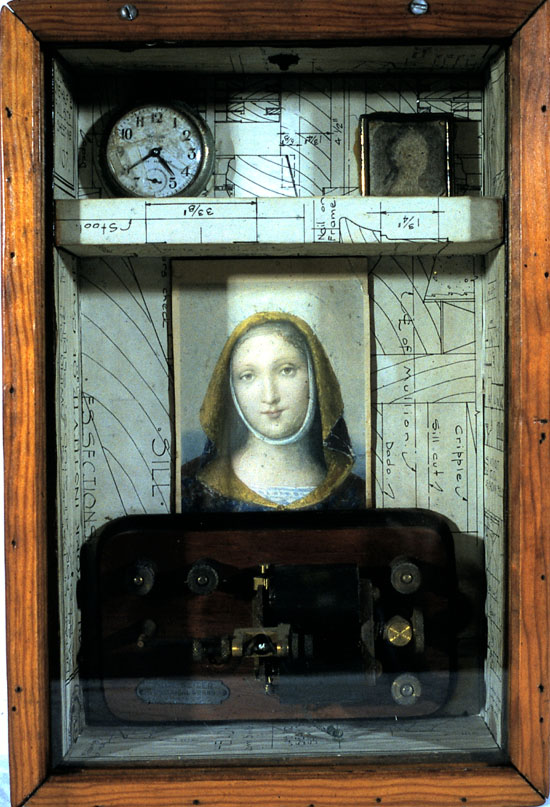about LAWRENCE JORDAN an excerpt from Semina Culture: Wallace Berman & His Circle by Stephen Fredman & Michael Duncan with Christine McKenna
“Known principally as a maverick spirit in the world of avant-garde American cinema, Lawrence Jordan played an important role in the late 1950s and early 1960s San Francisco art scene. Jordan has made over fifty experimental films, including a number of fanciful, filmic animations made from collaged cut outs of Victorian engravings. The animations extend dreamlike imagery of collaged landscape into a cinematic realm of transformation and free form symbolism. Jordan Seeks to delve into the deep structures and Jungian connotations of the mythological images his films reference. His alchemical approach to imagery creates what he has called the “theater of the mind, which you construct. That is the Underworld… the realm of the imagination. You have to have a place to work with images.”
Born in Denver in 1934 to school teacher parents, Jordan was a stellar student at South Denver High School, Winning a scholarship to Harvard University. There he quickly lost interest in science after discovering the works of Sergei Eisenstein and other experimental European filmmakers. He began making films at University Film Club but suffered a kind of breakdown and returned to Denver after a year. With high school friend Stan Brakhage, he continued to experiment with film, and with other friends set up a little theater in Central City, Colorado in the summer of 1953
Hearing about Kenneth Rexroth and the Poetry scene of San Francisco, Jordan and his friends went to the West Coast, intending to find an audience for their film. Working as a hospital orderly, Jordan managed to become acquainted with the artistic community, soon finding himself playing Faust in Robert Duncan’s Faust Foutu at the Six Gallery, Performing alongside Jess, Duncan, Michael McClure, Helen Adam, and Jack Spicer. Still primarily interested in filmmaking, Jordan followed Brakhage to New York in 1955, where he was introduced to Maya Deren and Joseph Cornell- Both of whom would become major influences on his work.
Returning the next year to San Francisco, he ended up living in the apartment of Michael and Joanna McClure above Jay DeFeo and Wally Hendrick and next door to Joan and William Brown. Over the next three years, between stints as a seaman in the Merchant Marines and travels in the Far East, Jordan met Philip Lamantia, Wallace Berman, George Herms, and Bruce Conner, with whom he started Camera Obscura, a film Society that ran for a number of years. Jordan also established The Movie, San Francisco’s first 16mm experimental film theater in 1958. His seven-minute film Visions of a City (1957) featured Michael McClure walking the shimmering streets of San Francisco, while Triptych in Four Parts (1957) included footage of John Reed and the Berman family, as well as a reverie devoted to peyote. Jordan’s Poem “Rockets” which Berman included in Semina 5 also celebrated the explosive, revelatory power of the ancient drug.
In the late 1950s Jess Introduced Jordan to the collage novels of Max Ernst. These works inspired Jordan to begin making collages from cutout engravings and soon led to cinematic experiments with animated collage. Film writer P. Adams Sitney has Distinguished Jordan’s films from the contemporaneous animations of Harry Smith in their use of static engraved backdrop that enables them to achieve a greater narrative illusion.
In 1959 Jordan sent Joseph Cornell a copy of his handmade book of stills taken from Eisenstein’s Ivan the Terrible and the two began a correspondence. Over the next few years, Cornell commissioned Jordan to provide photographs and film sequences for him by mail. Jordan married Patricia Topalian in 1960 and, after the birth of their daughter Lorna, they moved to Larkspur, not far from the Bermans’ houseboat. Cornell soon was corresponding with the entire family, and sending Lorna collages and trinkets. In 1965 Cornell asked Jordan to come east to be his assistant. Living for a month in Cornell’s house in Flushing, Jordan worked on box assemblages, edited Cornell’s film Legend of Fountains and shot new footage for him, in addition to making the only film of Cornell at work.
As the 1960s progressed, Jordan became well-known for animated shorts such as Due Concertants (1964) andGymnopedies(1966) that used freely associated streams of engraved images. The second part of the former film featured a fixed photographic image of Patricia Topalian Jordan looking out on a tree-lined lake while animated woodcuts and etchings appear in the distance. Jordan spent nearly a half-decade making the eighty-six minute animated feature Sophie’s Place (1983- 87) in which 129,600 single framed images envelop the mosque of Saint Sophia in Istanbul. The film, dubbed by Jordan “an alchemical autobiography” explores the variety of manifestations of Sophia, the Greek and Gnostic embodiment of wisdom. Another major effort, Jordan’s 1990 collage animation, The Visible Compendium, tracks the mysterious and metaphorically rich voyage of the hot air balloon.
Jordan started the film department of the San Francisco Art institute in 1969 and taught there for over thirty years. He made his own box assemblages in Cornell’s lyrically evocative style since the mid-1960s. Many feature ingenious mechanical and kinetic effects. He continues to make films and box collages at his home and studio in Petaluma where he has lived since 1978.”
Jordan’s solo show Prodigies of Physical Phenomena opens at K. Imperial on Thursday, April 4th. The artist reception will be Saturday, April 6th from 3-5pm. And the gallery will be open late (until 7pm) on Thursday, April 4th.
Jordan’s work will be included in An Opening of the Field: Jess, Robert Duncan and Their Circle which opens at the Crocker Museum on June 9th.



